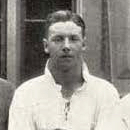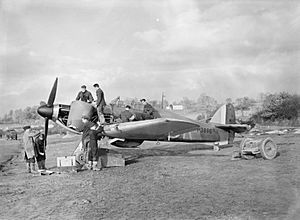Basil Collyns facts for kids
Quick facts for kids
Basil Collyns
|
|
|---|---|

Collyns in 1931
|
|
| Nickname(s) | Buck |
| Born | 24 February 1913 Greymouth, New Zealand |
| Died | 20 August 1944 (aged 31) near Rouvres, France |
| Allegiance | New Zealand |
| Service/ |
Royal New Zealand Air Force |
| Years of service | 1939–1944 |
| Rank | Flight Lieutenant |
| Unit | No. 238 Squadron No. 1 Squadron No. 243 Squadron No. 65 Squadron No. 19 Squadron |
| Battles/wars | Second World War
|
| Awards | Distinguished Flying Cross |
Basil Gordon Collyns (born February 24, 1913 – died August 20, 1944) was a brave New Zealand pilot. He was a "flying ace" during the Second World War. This means he shot down at least five enemy aircraft. He flew for the Royal New Zealand Air Force (RNZAF).
Basil Collyns was born in Greymouth, New Zealand. He joined the RNZAF in 1939. After his flight training, he went to the United Kingdom. There he served with the Royal Air Force. He flew Hawker Hurricane planes. He even took part in the Battle of Britain. Later, he flew Supermarine Spitfire and North American P-51 Mustang fighters. He was sadly killed in action in France in August 1944.
Contents
Early Life and Joining Up
Basil Gordon Collyns was born in Greymouth, New Zealand. His birthday was February 24, 1913. He went to Nelson College from 1925 to 1930. He was even the school's boxing champion in 1927. After college, he studied farming. Then he became a sheep farmer in Kaikōura.
Basil was very interested in flying. In March 1939, he tried to join the Royal Air Force. He didn't get in at first. But he joined a local flying club. He was put on a list of pilots who could be called to serve.
Serving in World War II
In November 1939, the Second World War had started. Basil, who was nicknamed "Buck," was called to join the Royal New Zealand Air Force. He started his flight training in December. By May 1940, he had earned his pilot's "wings." This meant he was ready to fly. He was made a pilot officer. Two months later, he sailed to the United Kingdom. He was going to fly for the Royal Air Force. Before he left, he got married in Blenheim.
When he arrived in the UK, Basil learned to fly the Hawker Hurricane fighter plane. This was a very important plane in the war. In late September, he joined No. 238 Squadron.
The Battle of Britain
When Basil joined No. 238 Squadron, they were fighting in the Battle of Britain. This was a huge air battle. German planes were trying to bomb London and other cities. British and Allied pilots fought hard to defend the country. Basil flew five missions during this time. He then briefly joined another squadron, No. 601 Squadron. He flew one mission with them. Then he returned to his original unit. By late November, the main part of the battle was over. Flying missions became less frequent.
Fighting Over the Channel
In May 1941, Basil moved to No. 1 Squadron. He flew 36 missions with them. On June 21, he achieved his first aerial victory. He shot down a German Messerschmitt Bf 109 fighter plane. This happened near Boulogne, France. A week later, he was promoted to flying officer.
After completing his missions, he became an instructor. He taught other pilots how to fly and fight. In June 1942, he returned to flying missions. He was promoted again, to flight lieutenant. He joined No. 243 Squadron. This unit flew Supermarine Spitfire fighters. They patrolled the coast and stopped German bombers. Basil later moved to other Spitfire squadrons. He also spent time at a special unit. There, he helped develop new air fighting techniques. In February 1943, his plane was in a mid-air crash. The other pilot died, but Basil managed to land safely. He then went back to teaching gunnery to new fighter pilots.
Supporting D-Day
In January 1944, Basil returned to active flying. He joined No. 65 Squadron. This squadron flew the new North American P-51 Mustang fighter. They were the first RAF squadron to use this plane. Their job was to fly over France. They escorted bombers and attacked targets on the ground. This was all to support Operation Overlord. This was the secret plan for the D-Day landings in Normandy.
On April 19, Basil helped damage two German planes on the ground. These were a Junkers Ju 52 transport plane and a Bf 109. On May 17, he shot down a Junkers Ju 88 bomber. He also shared in destroying another one. On June 10, he destroyed another Bf 109 near Caen, France.
On June 15, Basil moved to No. 19 Squadron. They also flew Mustang III planes. On June 20, he damaged a Focke Wulf 190 fighter. Two days later, his Mustang was hit by anti-aircraft fire. He had to bail out of his plane. Luckily, Allied soldiers found him. He was able to return to his unit.
On August 9, he destroyed another Fw 190. He also shared in destroying another one. On August 15, he damaged two more Fw 190s. He also probably destroyed a Bf 109. On August 20, he was flying east of Paris. He shot down an Fw 190. But then, his own plane was hit. His Mustang crashed near Rouvres. Basil was killed.
Awards and Legacy
Basil Collyns was given the Distinguished Flying Cross after he died. This award is for great bravery in air operations. The official announcement said he showed amazing skill and courage. He led his flight well and caused a lot of damage to the enemy. It also said he destroyed 7 enemy aircraft and damaged many others.
By the time he died, Basil Collyns was officially credited with destroying five German aircraft. He also shared in destroying two more. He probably destroyed one, and damaged three others. He also damaged two German planes on the ground. He was first buried in Rouvres. After the war, his remains were moved to a cemetery near Paris.



